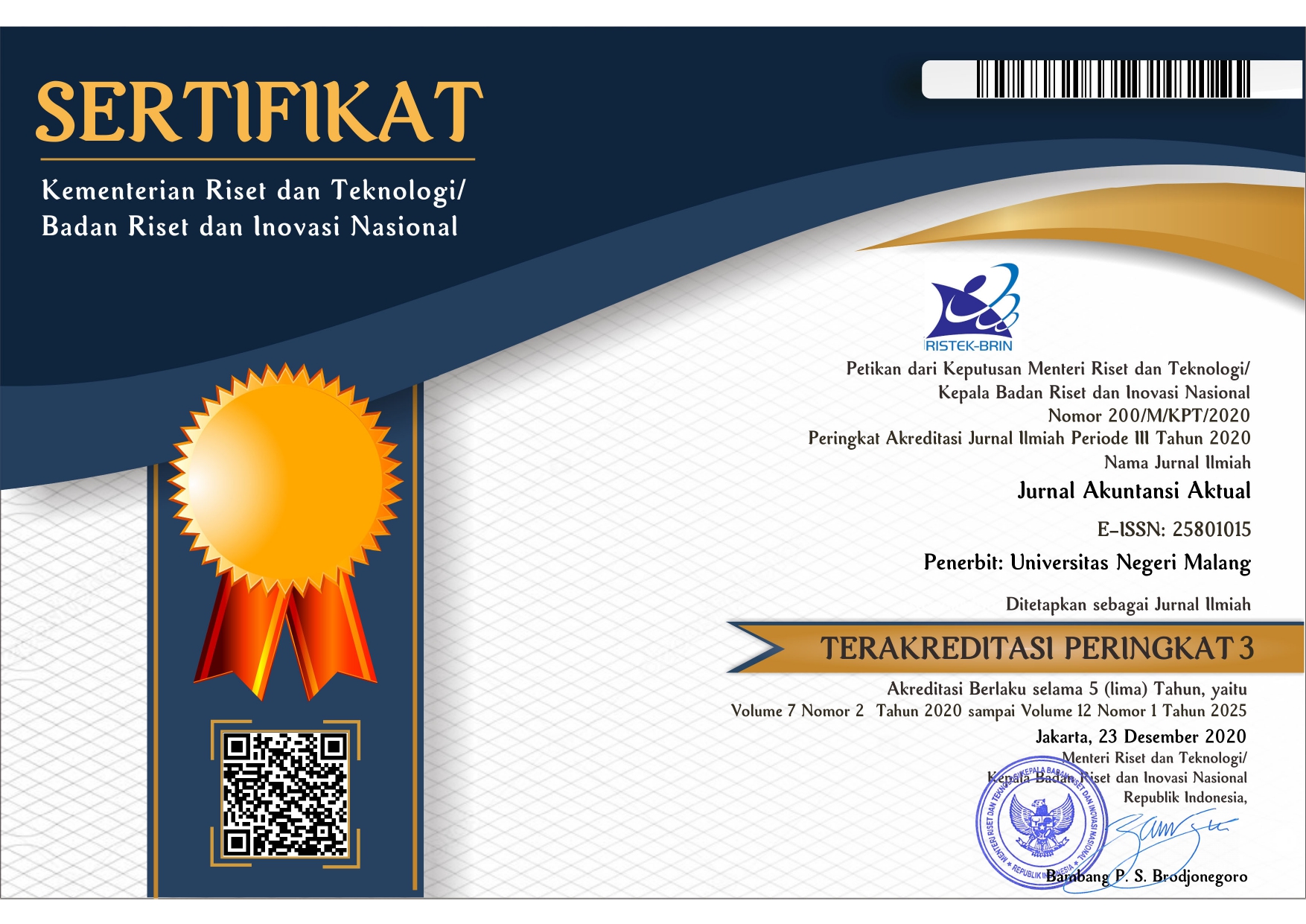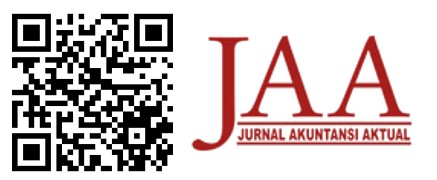Kecurangan pelaporan keuangan organisasi kemahasiswaan: perspektif crowe’s fraud pentagon theory
Abstract
Abstract
This study aims to investigate the practice of fraudulent accountability reports on Student Organization at State University X based on the perspective of fraud pentagon theory. This research used qualitative methods with a case study approach. The type of case study was multiple-case conducted on Student Organizations at State University X. Data were obtained through interviews, observations, and documentation of relevant data related to Student Organizations’ financial reporting practices. The data was then analyzed by the fraud pentagon theory. The research findings indicate that the practice of public fraud was caused by elements of the pentagon fraud. There are similarities and differences in the types of pentagon fraud elements encountered by the management committee. This is due to the existence of different policies in each community in a campus.
Abstrak
Penelitian ini memiliki tujuan untuk mengetahui praktik kecurangan laporan pertanggungjawaban organisasi kemahasiswaan di Universitas Negeri X jika ditinjau dari perspektif fraud pentagon theory. Penelitian ini menggunakan metode kualitatif dengan pendekatan studi kasus. Jenis studi kasus yang digunakan adalah multi kasus yang dilakukan pada organisasi kemahasiswaan di Universitas Negeri X. Data diperoleh melalui wawancara, observasi dan, dokumentasi data yang relevan terkait dengan praktik pelaporan keuangan organisasi kemahasiswaan. Data kemudian dianalisis dengan fraud pentagon theory. Hasil temuan penelitian menunjukkan bahwa praktik kecurangan organisasi kemahasiswaan disebabkan oleh elemen-elemen fraud pentagon. Terdapat persamaan dan perbedaan jenis elemen fraud pentagon yang dihadapi pengurus organisasi kemahasiswaan. Hal ini disebabkan adanya kebijakan yang berbeda di masing-masing organisasi kemahasiswaan dalam satu kampus.
Keywords
Full Text:
PDFReferences
Abdullahi, R., & Mansor, N. (2015). Fraud triangle Theory and Fraud Diamond Theory. Understanding The Convergent and Divergent for Future Research. International Journal of Academic Research in Accounting, Finance, and Management Sciences, 5(4), 38–45. doi:10.6007/IJARAFMS/v5- 3/1823.
American Institute of Certified Public Accountants (AICPA). (2002). Consideration of Fraud In A Financial Statement Audit. Statement on Auditing Standards No. 99. AICPA.
Avortri, C., & Agbanyo, R. (2020). Determinants of Management Fraud in The Banking Sector of Ghana: The Perspective of The Diamond Fraud Theory. Journal of Financial Crime, 17 July 2020. doi:10.1108/JFC-06-2020-0102.
Danuta, K. S. (2017). Crowe’s Fraud pentagon theory dalam Pencegahan Fraud pada Proses Pengadaan melalui E-Procurement. Jurnal Kajian Akuntansi, 1(2), 161-171. doi:10.33603/jka.v1i2.826.
Free, C. (2015). Looking through The Fraud triangle: A Review and Call for New Directions. Meditari Accountancy Research, 23(2), 175–196. doi:10.1108/MEDAR-02-2015-0009.
Hamilton, E. (2016). Evaluating The Intentionality of Identified Misstatements: How Perspective Can Help Auditors in Distinguishing Errors From Fraud. Auditing: A Journal of Practice & Theory, 35(4), 57–78. doi:10.2308/ajpt-51452.
Hogan, C., Rezaee, Z., Riley, R., & Velury, U. (2008). Financial Statement Fraud: Insights from The Academic Liteature. Auditing: A Journal of Practice and Theory, 27(2), 231–252. doi:10.2308/ aud.2008.27.2.231.
Karyono. (2013). Forensik Fraud. Yogyakarta: Andi Offset.
Lazarus, R. S., & Folkman, S. (1984). Stress, Appraisal, and Coping. New York: Springer.
Marks, & Jonathan. (2012). The Mind Behind The Fraudsters Crime: Key Behavioral and Environmental Elements. Chicago: Crowe Horwarth LLP.
Mayhew, B., & Murphy, P. (2014). The Impact of Authority on Reporting Behavior, Rationalization and Affect. Contemporary Accounting Research, 31(2), 420–443. doi:10.1111/1911-3846.12037.
Miles, M. B., & Huberman, A. . (1992). Analisis Data Kualitatif: Buku Sumber tentang Metode- Metode Baru. Jakarta: Universitas Indonesia.
Moleong, L. J. (2004). Metode Penelitian Kualitatif. Bandung: PT. Remaja Rosdakarya.
Muhsin, M., Kardoyo, M., & Nurkhin, A. (2018). What Determinants of Academic Fraud Behavior? from Fraud triangle to Fraud Pentagon Perspective. International Conference on Economics, Business and Economic Education, 3(10), 154–167. doi:10.18502/kss.v3i10.3126.
Murphy, P. (2012). Attitude, Machiavellianism and The Rationaliation of Misreporting. Accounting, Organizations and Society., 37(4), 242–259. doi:10.1016/j.aos.2012.04.002.
Murphy, P., & Dacin, M. T. (2011). Psychological Pathways to Fraud: Understanding and Preventing Fraud in Organisations. Journal of Business Ethics, 101(4), 601–618. doi:10.1007/s10551-011- 0741-0.
Puspitasari, Ragil, Y., Haryadi, B., & Setiawan, A. R. (2015). Sisi Remang Pengelolaan Keuangan Organisasi Mahasiswa. Jurnal Akuntansi Multiparadigma, 6(1), 133-144, doi:10.18202/ jamal.2015.04.6001.
Rae, K., & Subramaniam, N. (2008). Quality of Internal Control Procedures: Antecedents and Moderating Effect on Organisational Justice and Employee Fraud. Managerial Auditing Journal, 23(2), 104–124. doi:10.1108/02686900810839820.
Salsabil, Mutiara, S., Utami, I., & Hapsari, A. N. S. (2019). Fraud dan Whistleblowing: Tinjauan Pengelolaan Dana Organisasi Kemahasiswaan. Universitas Kristen Satya Wacana: Junal Akuntansi Bisnis, 12(1), 64–76.
Setiawan, Redy, A., Irianto, G., & Achsin, M. (2013). System-Driven (n)Fraud: Tafsir Aparatur terhadap “Sisi Gelap” Pengelolaan Keuangan Daerah. Jurnal Akuntansi Multiparadigma, 4(1), 85-100. doi:10.18202/jamal.2013.04.7184.
Skousen, C. J., Smith, K. R., & Wright, C. J. (2009). Detecting and Predicting Financial Statement Fraud: The Effectiveness of The Fraud triangle And SAS No. 99. Advance In Financial Economic, 13, 58–81. doi:10.1108/S1569-3732(2009)0000013005.
Tiffani, Laila, & Marfuah. (2015). Deteksi Financial Statement Fraud dengan Analisis Fraud triangle pada Perusahaan Manufaktur yang Terdaftar di Bursa Efek Indonesia. Jurnal Akuntansi dan Audit Indonesia, 19(2), 122–125. doi:10.20885/jaai.vol19.iss2.art3
Trompeter, G., Carpenter, T., Desai, N., Jones, K., & Riley, D. (2013). A Synthesis of Fraud-Related Research. Auditing. A Journal of Practice and Theory, 32(1), 287–321. doi:10.2308/ajpt-50360.
Wolfe, D., & Hermanson, D. (2004). The Fraud Diamond: Considering the Four Elements of Fraud. CPA Journal, 12(Exhibit 1), 1–5.
Yin, R. K. (2009). Studi Kasus: Desain dan Metode. Jakarta: PT. Rajagrafindo Persada.
DOI: http://dx.doi.org/10.17977/um004v8i12021p051
Refbacks
- There are currently no refbacks.

This work is licensed under a Creative Commons Attribution-ShareAlike 4.0 International License.
Jurnal Akuntansi Aktual is indexed by:

















